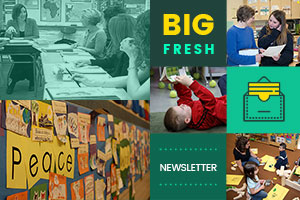The mind once expanded with the knowledge of duct tape never returns to its original size.
Shaun Holloway
One day late last fall, I received an order of classroom supplies. The students were excited to see what all the boxes contained.
“Open them now!” they clamored.
Without a teaching point in mind, I began to open the boxes. What was in those boxes belonged to this community of readers, writers, and thinkers. Post-it notes, chart paper, colored pens, and highlighters were just a few of the treasures that emerged. I was methodical when ordering these supplies, knowing they would be tools to help us think. I was still surprised at what caught the students’ attention.
“Duct tape!! Oh my gosh! Angry Birds! Mickey Mouse! Owls! Tie-Dye! Penguins! Flower Power! Peace signs! Paint splatter! This is the best duct tape ever!”
Everyone seemed mesmerized by the choices of duct tape. More important, their next question really changed our writing workshop and publishing for the rest of the year.
“Can we use this tape to make our books?”
At the time, that seemed like a silly question to me. Of course, they could use the duct tape to publish their books and stories. That is why I had spent my budget that way; I wanted resources for them to be independent publishers.
But, after reflection, the question made more sense to me. Looking back at the ways I had encouraged students to publish previously that year, the choices were almost entirely digital. We live in a digital world and I wanted students to be comfortable making their writing and stories public that way.
What I hadn’t taken into account was the magic of creating a book, and in this case, the missing piece of that magic was the duct tape found in these boxes. The publishing in our classroom after that order came in grew exponentially. It turns out that students love to make books; it gives them a feeling of pride and ownership. Unlike digital publishing, creating a physical book yields a tangible product.
The display bookcase in our classroom became jammed with all the books and stories that were being published. It got so bad at one point that books were three and four deep, and we couldn’t even see everyone’s wonderful work. I devoted a writing minilesson to deciding together what books could stay and what books needed to be taken home to share and enjoy.
The learning for me in all this? A container of quirky duct tape options, a whole lot of choice in what students write and publish, and voila – books are born and students feel empowered.
This week we look at word work in the early grades. Plus more as always — enjoy!
Karen Terlecky
Contributor, Choice Literacy
Karen Terlecky has been been teaching for over 30 years. Her new position is as an instructional coach in the Dublin (Ohio) City Schools. Karen is featured on the Choice Literacy DVD Two Workshops: Contrasting Primary and Intermediate Literacy Workshops and blogs at Literate Lives.
Free for All
[For sneak peeks at our upcoming features, quotes and extra links, follow Choice Literacy on Twitter: @ChoiceLiteracy or Facebook: http://www.facebook.com/ChoiceLiteracy or Pinterest: http://pinterest.com/choiceliteracy/]
Here are two features from the archives to help you look at word learning in new ways.
Amanda Adrian and Heather Rader are helping kids learn how to be Word Nerds:
http://www.choiceliteracy.com/articles-detail-view.php?id=1835
Shari Frost suggests texts for joyful exploration of words in Books for Phonics Instruction: Accomplishing More Than Sounding Out Words
http://www.choiceliteracy.com/articles-detail-view.php?id=420
Start a new tradition, All Hallow’s Read, by giving out favorite spooky books for Halloween. This is in addition to and not in place of candy — you don’t want your house to get egged:
http://www.allhallowsread.com/
Here is a fun graphic to start conversations about how long it takes to read favorite books:
For Members Only
Max Brand explains Word Work Basics, including a list of reflective questions teachers can ask themselves and students:
http://www.choiceliteracy.com/articles-detail-view.php?id=2103
Katie DiCesare shares how she makes the most of transitions by having her first-grade students contribute to a Blends Chart. The feature includes a quick video snippet of children adding to the chart:
http://www.choiceliteracy.com/articles-detail-view.php?id=1595
Gretchen Taylor has a common teacher’s lament — My Middle Schoolers Can’t Spell. This is the first installment in two-part series:
http://www.choiceliteracy.com/articles-detail-view.php?id=2090
In this week’s video, Christi Overman teaches her second graders about onomatopoeia in a brief minilesson:
http://www.choiceliteracy.com/articles-detail-view.php?id=1667
In an encore video, Beth Lawson confers with a second grader and teaches the writing strategy of stretching words:
http://www.choiceliteracy.com/articles-detail-view.php?id=640
That’s all for this week!



